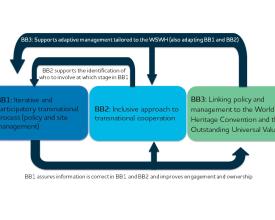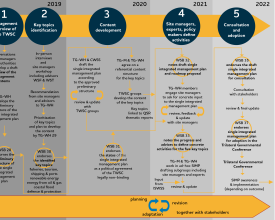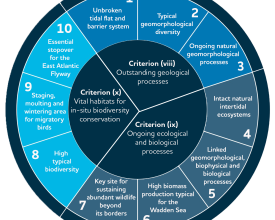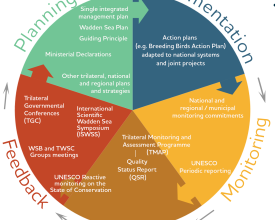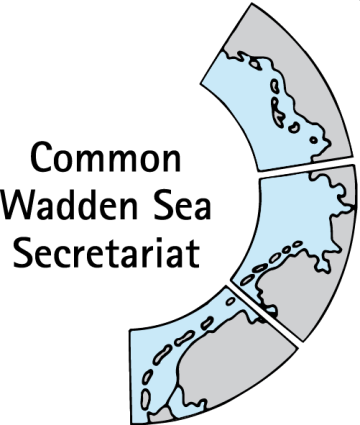
Proceso participativo de elaboración del plan único de gestión integrada del sitio transnacional del Mar de Wadden, Patrimonio Mundial (SIMP)

El plan único de gestión integrada (SIMP) es un plan general para el sitio transnacional del Patrimonio Mundial del Mar de Wadden de la UNESCO (DK, DE, NL) y complementa el Plan del Mar de Wadden (2010), que contiene los objetivos y políticas acordados trilateralmente. Con el desarrollo del SIMP, la Cooperación Gubernamental Trilateral para la protección del Mar de Wadden (TWSC) sigue la petición oficial realizada por el Comité del Patrimonio Mundial en 2014. El plan se elaboró de forma iterativa y participativa en la TWSC, incluidos los niveles políticos y de gestión de sitios a escala transnacional. Su objetivo es seguir facilitando la mejora continua de la coordinación de la gestión transfronteriza para la protección y el mantenimiento del Valor Universal Excepcional del sitio del Patrimonio Mundial del Mar de Wadden.
Contexto
Défis à relever
- Las diferencias en las estructuras políticas y administrativas y en las prácticas de gestión generalmente aceptadas entre los tres países del Mar de Wadden (por ejemplo, la interpretación y aplicación de la legislación de la UE en la legislación nacional, las competencias de las administraciones de protección de la naturaleza y los gestores no gubernamentales de los sitios) plantean retos a la hora de cumplir las intenciones políticas expresadas de gestionar el Patrimonio Mundial del Mar de Wadden como UNA entidad común.
- La gestión eficaz del Patrimonio Mundial del Mar de Wadden debe abordar de forma integradora las actividades clave que afectan al bien, incluidas las actividades económicas más importantes, salvaguardando al mismo tiempo el Valor Universal Excepcional (VUE) del sitio.
Ubicación
Procesar
Resumen del proceso
Un método iterativo y participativo es la base y el principio fundamental para desarrollar con éxito un SIMP. Esto no sólo permite reunir la información más actualizada y correcta, sino que fomenta el flujo de información entre la política y la gestión del sitio de forma trilateral. BB1 proporciona la base necesaria para construir un enfoque inclusivo adecuado para la cooperación transnacional (BB2), así como apoya la construcción de una comprensión compartida de la vinculación de la política y la gestión con los requisitos del Patrimonio Mundial (BB3). BB2 permite identificar e implicar en el proceso a los niveles y partes interesadas adecuados (BB1) y BB3 informa y orienta el proceso (BB1) para adaptar la política y la gestión cuando sea necesario.
Bloques de construcción
Proceso iterativo y participativo de planificación de la conservación de la naturaleza (a nivel de gestión de sitios y de políticas)
El propósito es lograr un plan de gestión transfronteriza de éxito que integre los niveles necesarios para una gestión eficaz. Un ejercicio para imaginar qué haría que el SIMP fuera un éxito resultó útil para gestionar las expectativas y orientar y adaptar el proceso.
- Fase preparatoria: el Grupo de Trabajo trilateral Patrimonio Mundial, que supervisa el desarrollo del SIMP, acordó el propósito de mejorar la coordinación de la gestión a nivel trilateral. Teniendo en cuenta las sugerencias de los niveles de gestión y política de los sitios y las Directrices operativas para la aplicación de la Convención del Patrimonio Mundial, se acordaron una hoja de ruta y un contenido.
- El desarrollo del contenido en el TWSC: se basa en la gobernanza existente de la cooperación. Los grupos de trabajo apoyaron la redacción del contenido del SIMP en relación con los efectos del cambio climático y la adaptación al mismo, la educación, el turismo sostenible, la investigación, el seguimiento, la evaluación, etc. El contenido preliminar fue revisado y enriquecido de forma iterativa por los grupos del TWSC, los gestores de los sitios, el grupo de trabajo trilateral Patrimonio Mundial y el Consejo del Mar de Wadden.
- Consulta más allá del TWSC: las partes interesadas externas y los miembros de los consejos consultivos de cada uno de los Estados Federados alemanes, Dinamarca y los Países Bajos revisaron y comentaron el proyecto de SIMP.
Está previsto un proceso similar para evaluar los avances y adaptar las actividades.
Factores facilitadores
- La actual estructura de gobierno del TWSC incluye grupos de trabajo sobre temas relevantes para el Patrimonio Mundial del Mar de Wadden y, por tanto, el plan único de gestión integrada (SIMP). El mandato para desarrollar el SIMP (que implica la gestión del sitio y el nivel político) se dio en la Declaración Gubernamental Trilateral como respuesta a la petición del Comité del Patrimonio Mundial.
- Compromiso existente del Grupo de Trabajo Patrimonio Mundial.
- Compromiso de recursos de las partes y un miembro adicional del personal del CWSS como responsable del proyecto SIMP.
Lección aprendida
- Dedique tiempo suficiente a la participación: tenga en cuenta que cada país tiene sus propios hábitos y estructuras de participación y que cada grupo implicado tiene su propio ritmo y procesos que seguir. Infórmese sobre ellos e intégrelos lo mejor posible.
- Planifique los debates entre las partes implicadas: algunos aspectos requieren más tiempo e información previa para comprender las posturas y proponer soluciones. El Grupo de Trabajo Trilateral del Patrimonio Mundial fue una gran plataforma con miembros que son el enlace con el nivel político y de gestión de los sitios.
- Una comunicación eficaz, fácil y adaptada es clave a todos los niveles y en todas las fases para transmitir los mensajes clave. Aquí aprendimos sobre la marcha y mejoramos, pero es posible seguir mejorando.
Enfoque integrador de la cooperación transnacional
El objetivo es lograr una buena comprensión transfronteriza de los sistemas nacionales de conservación de la naturaleza y del modo en que las personas y organizaciones implicadas colaboran a nivel trilateral. Este profundo conocimiento contribuye a mejorar la aplicación de una gestión coordinada y a vincular las políticas, planes y actividades nacionales con las trilaterales (y viceversa).
En la Cooperación Gubernamental Trilateral, cada país tiene su propia cultura política y sus propias prioridades. Esto influye en las estructuras gubernamentales y de la sociedad civil y, por tanto, en los procesos de toma de decisiones, lo que a su vez influye en la conservación y gestión de la naturaleza.
Las estructuras nacionales de conservación de la naturaleza aclaran cuáles son las distintas organizaciones públicas y los distintos niveles geopolíticos responsables de la planificación, la elaboración de políticas y la ejecución de las actividades de conservación de la naturaleza sobre el terreno. También se requiere una definición de los gestores de los sitios de conservación de la naturaleza, sus funciones y competencias por país. Estos elementos son fundamentales a la hora de elaborar un plan transnacional de gestión integrada (SIMP).
Todos los grupos con competencias en conservación de la naturaleza están representados en la estructura de gobernanza trilateral. Algunos en el órgano decisorio, el Consejo del Mar de Wadden, y otros en los distintos grupos de trabajo.
Factores facilitadores
A las organizaciones gubernamentales implicadas en la conservación de la naturaleza les interesa expresar y aclarar sus funciones y competencias a nivel nacional. Esto ayuda a gestionar y ajustar las expectativas, así como a diseñar una estructura trilateral que incluya a las organizaciones y grupos no gubernamentales pertinentes.
Lección aprendida
- No siempre es fácil entender las estructuras y procesos de gestión debido a las diferentes culturas políticas de los tres países. Es bueno contar con personas que puedan "traducir" las estructuras a un "lenguaje común".
- Es bueno contar con estructuras correctas, claras y completas para asegurarnos de que en el proceso de elaboración del plan único de gestión integrada estamos implicando a las organizaciones adecuadas en las fases adecuadas del proceso iterativo y participativo transnacional (véase BB1).
- Comprender las estructuras también ayuda a entender el proceso de elaboración de políticas, los planes de gestión relacionados con las Directivas de la UE y la actualización de las estrategias y agendas nacionales, facilitando la detección de momentos importantes para considerar políticas, estrategias y planes trilaterales nacionales con la ayuda de los miembros del TWSC.
- Comprender las estructuras y procesos nacionales de conservación de la naturaleza también ayuda a entender mejor cómo se están aplicando en cada país otros compromisos nacionales y regionales (por ejemplo, las Directivas y Estrategias de la UE).
Vinculación de la política y la gestión con la Convención del Patrimonio Mundial y el Valor Universal Excepcional
El propósito es añadir criterios y valores específicos del Patrimonio Mundial para complementar la gestión de conservación de la naturaleza existente, subrayando así que la designación de Patrimonio Mundial es el máximo reconocimiento internacional para un área natural.
Las Directrices prácticas para la aplicación de la Convención del Patrimonio Mundial (§ 111) establecen que un ciclo de gestión adaptable de planificación, aplicación, seguimiento, evaluación y retroalimentación es uno de los elementos de una gestión eficaz. En el proceso de elaboración del SIMP, los instrumentos de gestión del TWSC existentes (actividades, políticas, planes y estrategias) se organizan y visualizan en las fases correspondientes del ciclo de gestión adaptativa (véase el gráfico).
Para evaluar los efectos positivos y negativos existentes y potenciales sobre el Valor Universal Excepcional (VUE) del Patrimonio Mundial del Mar de Wadden, se identificaron diez valores clave a partir de los tres criterios que cumple el Mar de Wadden (método utilizado en el Índice de Vulnerabilidad Climática). Una rápida evaluación por expertos de los efectos positivos y negativos de los temas clave del SIMP en cada uno de los diez valores clave del VUE sirvió de apoyo a los debates sobre las posibles actividades de gestión (véase el gráfico).
Factores facilitadores
En 2021 se realizó una evaluación rápida de la vulnerabilidad al cambio climático basada en índices (Índice de Vulnerabilidad Climática - IVC) utilizando los valores clave del VUE.
La Convención del Patrimonio Mundial establece los deberes de los Estados Partes, sus funciones en la protección y conservación de los sitios, y proporciona orientación operativa sobre la aplicación de la Convención.
El TWSC se creó en 1978 como herramienta de cooperación y coordinación de la conservación de la naturaleza. Dinamarca, Alemania y los Países Bajos han creado de forma independiente y conjunta un sistema de gestión integral que aborda aspectos clave.
Lección aprendida
- Aunque ya se ha conseguido mucho y se está trabajando para alcanzar hitos importantes, aún quedan retos que afrontar.
- Por un lado, los resultados de las evaluaciones rápidas de expertos sobre los efectos positivos y negativos de los temas clave del SIMP en los valores clave del Valor Universal Excepcional (VUE) coinciden, en general, con los resultados de los debates y las opiniones de los responsables políticos y de los sitios. Por otro lado, si se dispone de recursos y tiempo, es preferible realizar estudios en profundidad que puedan revisarse y actualizarse periódicamente. Para solucionarlo, la Cooperación Trilateral del Mar de Wadden (TWSC) optó por integrar estas evaluaciones en los Informes sobre el Estado de la Calidad actualizados periódicamente por expertos.
Recursos
Impactos
- Participación de los gestores de los sitios de conservación de la naturaleza en la definición de los temas clave a tratar y en el desarrollo de posibles actividades de gestión trilateral.
- Mayor comprensión de cómo se organiza cada país para la gestión de la conservación de la naturaleza del sitio del Patrimonio Mundial y de cómo colaboran trilateralmente.
- Este proceso dio la oportunidad a los responsables políticos y a los gestores del sitio de contribuir en diferentes etapas, aumentando la apropiación del SIMP. Los miembros del Grupo de Trabajo trilateral del Patrimonio Mundial, compuesto por los gestores oficiales de los sitios del Patrimonio Mundial, son embajadores de su aplicación.
- La fase final de consulta invitó de nuevo a las partes interesadas a seguir mejorando las actividades propuestas.
- Restablece e intensifica el diálogo a largo plazo sobre los usos humanos, teniendo en cuenta el cambio climático, la pérdida de biodiversidad y los ambiciosos objetivos de transición energética.
- La distribución del SIMP a los responsables políticos, entre otros, y a escala regional contribuye a aumentar la concienciación y la comprensión sobre la gestión del sitio del Patrimonio Mundial y el papel de otros sectores en su aplicación.
- Vínculo directo con el Valor Universal Excepcional (VUE): evaluación rápida por expertos de los impactos sobre el VUE y vínculo con los informes periódicos sobre el estado de la calidad del Patrimonio Mundial del Mar de Wadden.
- Vínculo directo con el ciclo de gestión adaptativa de la Convención del Patrimonio Mundial.
- El SIMP contribuye a la aplicación de los reglamentos pertinentes de la UE mediante la formulación de posibles actividades de gestión.
Beneficiarios
A corto plazo, el Mar de Wadden y la TWSC son los principales beneficiarios del SIMP. En su aplicación, es de esperar que las comunidades asociadas al lugar, otros sectores y las partes interesadas vean un valor añadido en su participación.

